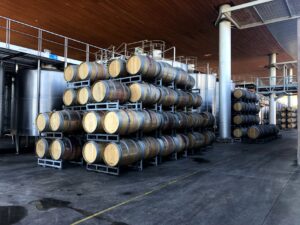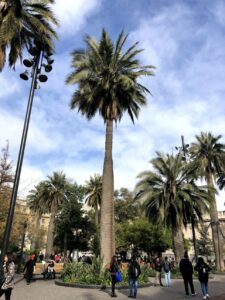On July 2, parts of South America witnessed a total solar eclipse, a fantastic spectacle when the new moon passes in front of the sun. The resulting shadow within the path of totality creates a darkness midday, with only the sun’s corona visible. I had the opportunity to visit the Elqui Valley in Chile to witness the eclipse. While there, I was also able to sample some delicious dishes, including a few that I had never had before.
When I travel, I always look forward to trying the local cuisine, to taste unique dishes. I look for recommendations from people who live in the area, and try to eat outside of my comfort zone. Something I was able to enjoy this trip was a local wine. One of my first stops was Valpariso, a port city about an hour and a half drive from Santiago. While there, I ate at Almacen Nacional, an eclectic and charming restaurant situated on the corner of a winding street. The waiter recommended the Casas Patronales Carmenere Riserva wine; paired with hake, a tasty white fish, this was perhaps my favorite meal I ate during my trip. The wine had interesting notes of dark cherry and bruised berry, with a slight oaky and vanilla character. Later during our trip, I visited the Tabali winery, where I learned more about this delicious grape. Carmenere originated in the Bordeaux region in France, and was brought to Chile in the 1800s. The grape thrived around Santiago and the rest of the country, while the Phylloxera plague of 1857 wiped out most of the Carmenere grapes in France. Carmenere grapes have high levels of pyrazines, which lend notes of green bell peppers to the wine; these are also found in other “Bordeaux” grapes, such as Cabernet Sauvignon and Merlot. The grape ripens slowly, about 4-5 weeks after Merlot, usually in autumn. The wine is also known to be juicy with smoky and spicy notes.

Another interesting meal I had was Conger eel soup, or caldillo de congrio, a popular Chilean dish. It was famously loved by the acclaimed Chilean poet Pablo Neruda, who wrote an ode to this unique soup. To make this dish, the eel heads are boiled with vegetables and spices. This broth is then strained and combined with vegetables, such as potatoes or tomatoes, and mixed with boiled conger. The resulting soup is hearty, salty, and filling, perfect for a cold winter day.
Lastly, I enjoyed a sweet treat, miel de palma, or palm honey. This comes from the palm tree Jubaea cilensis, native to central Chile. Their trucks are the thickest of all palm trees, and they are able to withstand subzero temperatures. In the past, these trees were harvested in large numbers for their sap; as a result, they are now protected, and are no longer endangered. The sap of this tree is what makes the miel de palma. I was able to try this syrup, and was fascinated with the taste; it tastes similar to maple syrup, but sweeter and with more caramel notes. It also tastes a bit nutty, and is thinner than honey. During the tour, I learned that miel de palma is very popular in Chile, and is added to many dishes, including pancakes and yogurt.

Let me know some unique dishes you’ve encountered through your travels!
Until the next adventure,
Garry Conklin
Further Reading:
https://www.palmpedia.net/wiki/Jubaea_chilensis
https://www.timeanddate.com/eclipse/total-solar-eclipse.html
https://winefolly.com/tutorial/10-cool-things-to-know-about-carmenere-wine/
https://winefolly.com/tutorial/pyrazines-why-some-wines-taste